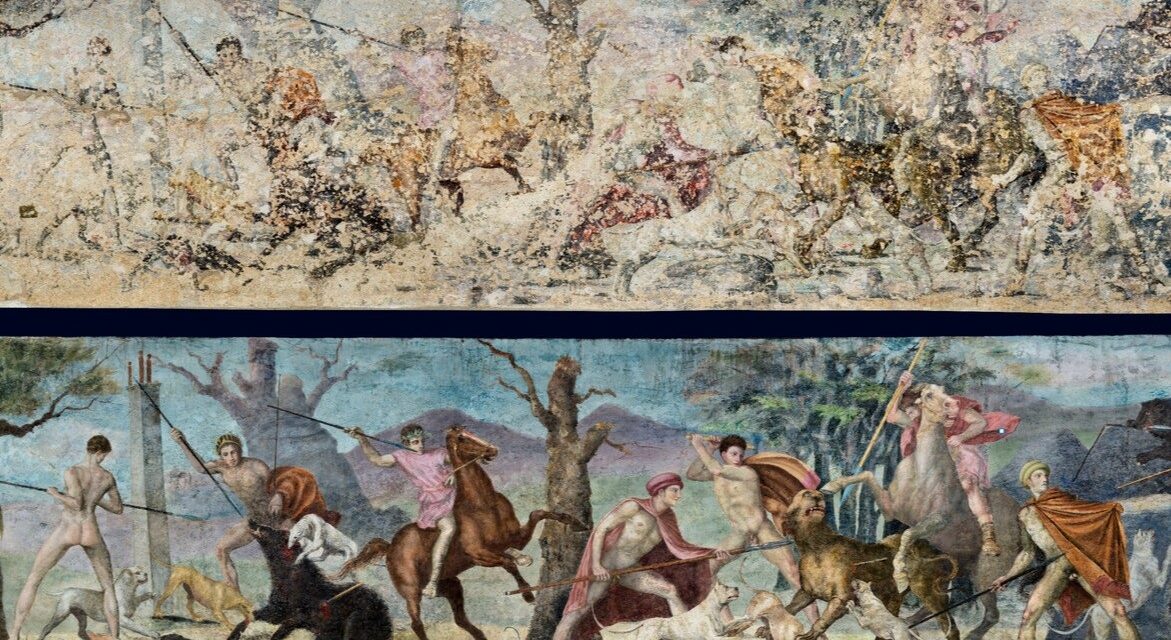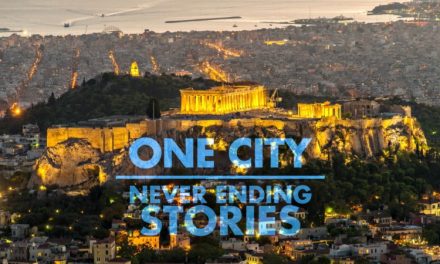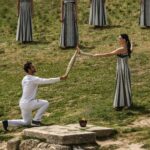The hunting fresco, which adorns the frieze on the façade of the royal tomb of Philip II at Aigai, is the most significant and largest known painting of the classical world to have been revealed to date.
The recently completed interdisciplinary ReVis project, led by archeologist Hariclia Brecoulaki, constitutes the first comprehensive and scientifically documented study of this fresco from Aigai. It employed pioneering, non-invasive diagnostic and imaging techniques based on digital technology. The monumental fresco, which nearly entirely covered the long frieze of the so-called Macedonian tomb — 5.56 meters long and 1.16 meters high — consists of six open-air hunting scenes.
New data regarding the ancient pigments, painting style, and iconography of this emblematic fresco, and more broadly, on the monumental Greek painting of the 4th century BCE, emerged through this innovative study, a collaboration between the National Hellenic Research Foundation, the National Centre For Scientific Research “Demokritos” and the Hemathia Ephorate of Antiquities.
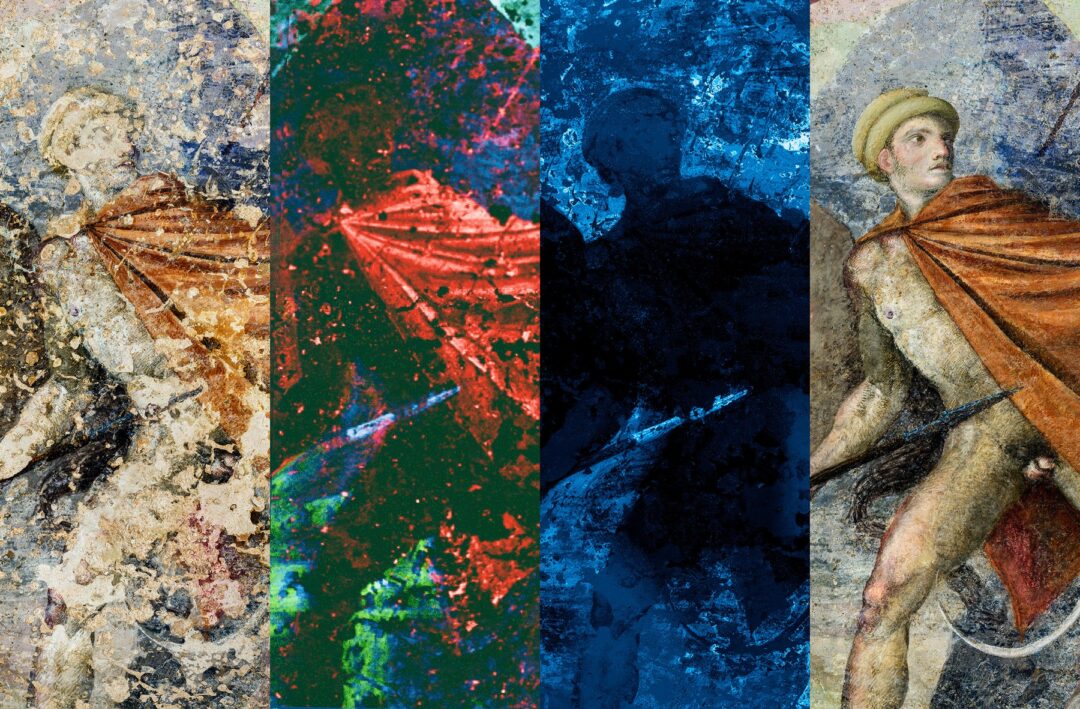
The ultimate goal of the research project was to gain a more accurate understanding of the fresco’s technique and iconography, as well as to propose a new digital restoration at its original scale, based on archaeometric data, combining AI tools (Christos Simatos, visual artist) and contemporary artistic creation (Emmanouil Bitsakis, painter).
Ancient Greek painting is a little-known facet of Greek art: few people realize that life in antiquity was full of paintings, from public buildings to private homes, made with delicate materials that haven’t survived — mostly painted on wood, hence their absence from museum collections.
The great painters of the 4th century BCE, the golden age of Greek painting, were highly sought-after, producing sophisticated works with advanced techniques that laid the foundation for painting in subsequent centuries.
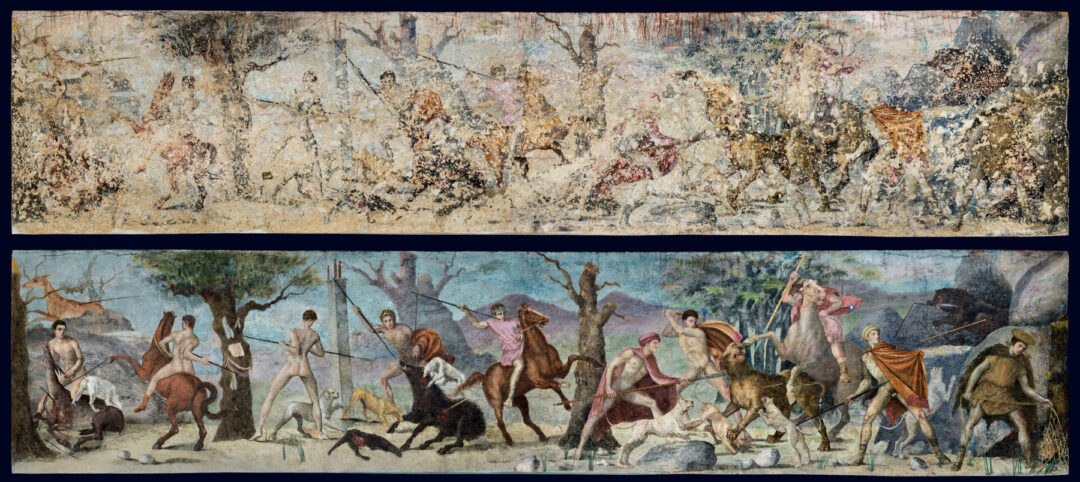
Dr Hariclia Brecoulaki, who has devoted her career to studying ancient Greek painting and color, is a senior researcher at the Institute of Historical Research of the National Hellenic Research Foundation, and the scientific lead for the digital restoration of the fresco. In her interview with Lifo, she stated:
“The striking composition of the royal hunt, created by a gifted 4th-century BCE painter on the façade of the imposing royal tomb before it was covered by the earthen mound, is internationally renowned and represents the most significant and largest-scale painting of the classical world discovered to date.
“Comprising six hunting scenes in an open landscape with perspectival elements, the composition includes three mounted and seven on-foot hunters wearing distinct clothing and accessories, and nine dogs attacking and injuring various types of game, primarily a boar and a lion. The setting blends natural and man-made elements, such as a rectangular column topped with statuettes. Despite the action, all animals are shown mortally wounded, with the hunters in full control — symbolizing dominance.
Thus, the hunt may serve as a metaphor for the battlefield, a display of power by the Macedonian kings, still resonating from their major victory at Chaeronea, in which Alexander played a crucial role. Many studies have focused on the frieze, proposing theories about the hunt’s meaning, its setting, the symbolism of multiple prey, the social roles of the hunters, and whether the figures correspond to historical Macedonian court members.
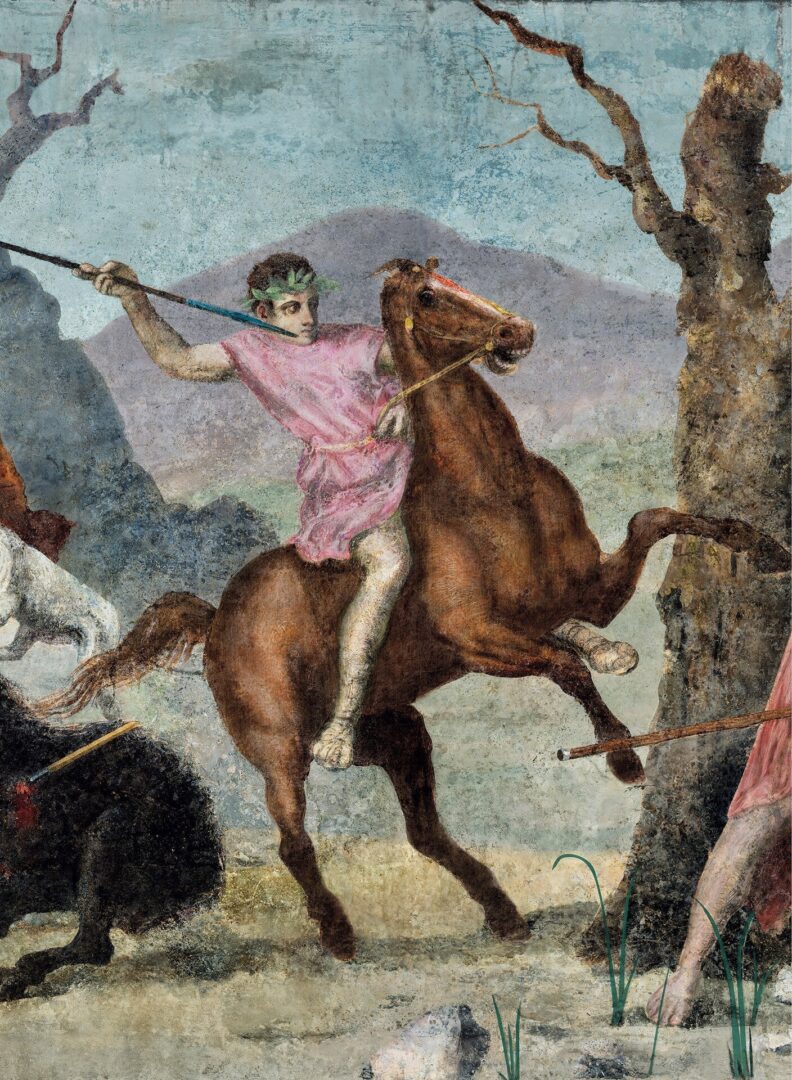
However, due to poor preservation and limited access, it remains difficult for viewers to appreciate its artistic value or decipher its iconography clearly. The belief that Greek painters practiced “tetrachromy” (painting using only four pigments: white, black, yellow, and red) influenced artistic and scholarly interpretations of Greek painting since the Renaissance.
In my research at the National Hellenic Research Foundation, I began in 2013 — with colleagues Andreas Karydas, Christos Simatos, and Giovanni Verri — a pilot diagnostic study of the hunting fresco from Philip’s tomb at Aigai. At that time, the Ephor of Antiquities in Imathia, Angeliki Kotaridi, supported us by granting permission and installing scaffolding on the tomb’s façade, enabling us to take sample color readings, photograph the scene, and apply imaging techniques that revealed colors and shapes invisible to the naked eye.
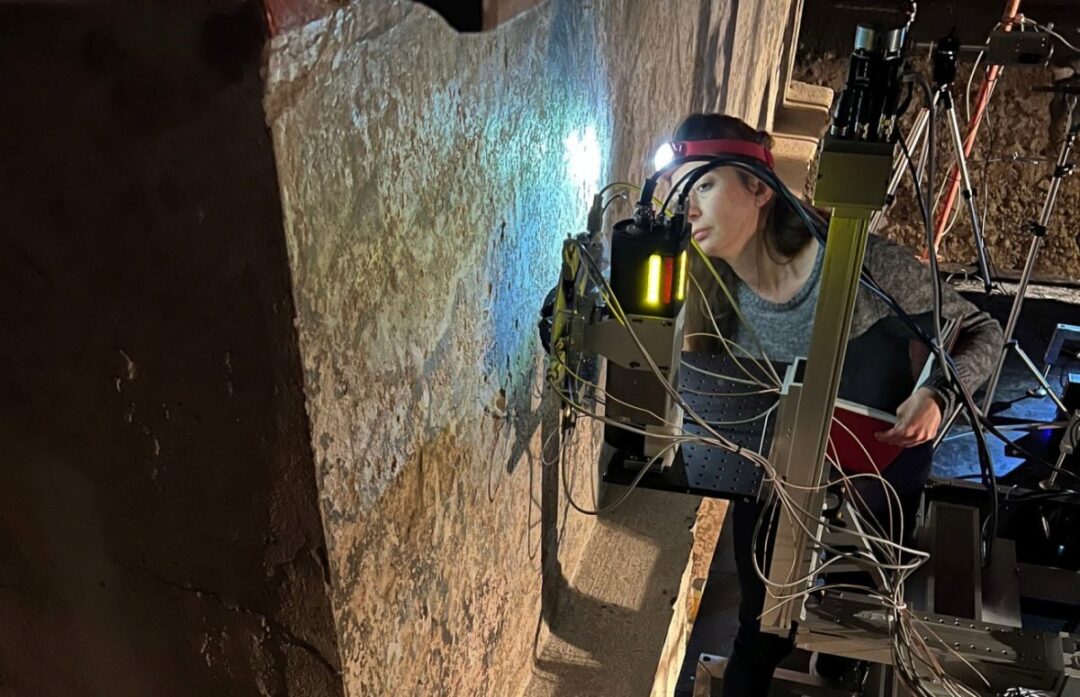
This initial study made it clear that the ancient painter used a wider range of pigments than previously believed, applied over large surfaces, and that the technique was extraordinarily complex for its time. Further analysis of color composition and painting technique was warranted. Additionally, through visible-induced luminescence and fluorescence photography, previously unseen drawing details emerged.
Ten years later, in March 2023, with funding from the Hellenic Foundation for Research and Innovation (HFRI), we organized — with a team of colleagues — the continuation and completion of the 2013 project as ReVis, an interdisciplinary endeavor combining archaeological expertise, archaeometric research, AI tools, and artistic interpretations.
The goal remains a better understanding of the fresco’s technique and imagery and a new digital restoration at life-size, based on the latest scientific findings — enabling a more accurate reconstruction of the original polychromy and offering modern audiences a clearer view of this unique masterpiece.
Today, the polychromy of ancient sculpture and architecture is more widely recognized thanks to various exhibitions and studies both in Greece (e.g., the Acropolis Museum, the Αcropolis Restoration Service-YSMA) and abroad (e.g., “Gods in Color“). However, monumental painting remains largely unseen. We felt this ambitious effort was worth undertaking.
We aimed to create a more faithful recreation of the original composition — to “revive” this masterpiece so it can be better studied by experts and appreciated by the general public.”
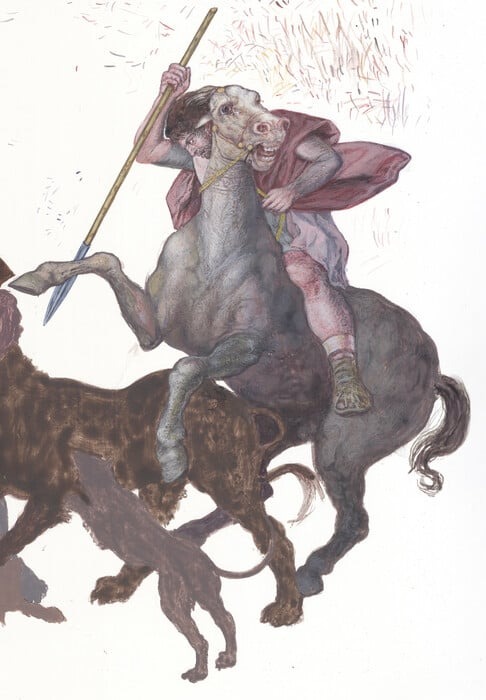
According to the Portal for the Greek Language, regarding the historical figures possibly depicted:
It’s difficult to determine whether the hunting scene in the Vergina fresco is a historical event — even loosely interpreted — or a symbolic, fictional composition. In either case, some of the mounted hunters are likely historical figures. Yet, identifying them and determining the exact date of the fresco — and of the tomb — remains challenging. If the tomb was built in the 340s–330s BCE, the bearded rider may be Philip II (d. 336 BCE) and the youthful, wreath-wearing rider Alexander the Great. If, instead, the tomb dates to the late 4th century BCE, the deceased could be Philip III Arrhidaeus, Alexander’s half-brother (d. 316 BCE). In any case, the fresco places us within the royal Macedonian milieu before the end of the 4th century BCE.
On April 5, 2025, an international conference titled “The Aigai Hunt Frieze Revealed: An Interdisciplinary Investigation and Digital Reconstruction“ presented the outcomes of the ReVis project. From April 9 to 12, a life-size digital print of the fresco’s restoration was exhibited, along with original artworks by Emmanouil Bitsakis, used in the reconstruction, at 16 Fokionos Negri Street.

ReVis was funded by the Hellenic Foundation for Research and Innovation (HFRI) under the “2nd Call for HFRI Research Projects to Support Faculty Members and Researchers” (Project No. 4366). Scientific supervisor is Dr. Haricleia Brecoulaci, Senior Researcher at the Institute of Historical Research of the National Hellenic Reasearch Foundation. The project is implemented in collaboration with the National Centre For Scientific Research “Demokritos,” led by Dr. Andreas Karydas, and the Hemathia Ephorate of Antiquities, with Dr. Anastasia Georgiadou as on-site scientific lead.
ReVis also benefited from access to the advanced facilities of the European IPERION-HS/MOLAB consortium.
I.L., with information from the Greek Ministry of Culture, Lifo, Ta Nea and Portal for the Greek Language.
Read more from Greek News Agenda:
- The Archaeological Site and Polycentric Museum of Aigai
- Archaeologist and ‘Archaeostoryteller’ Ted Papakostas on discovering the ‘entirety’ of Ancient Greece
- Meet “Demokritos” the biggest Research Centre of Greece

TAGS: ARCHAEOLOGY | ARTIFICIAL INTELLIGENCE | PAINTING | TECHNOLOGY

